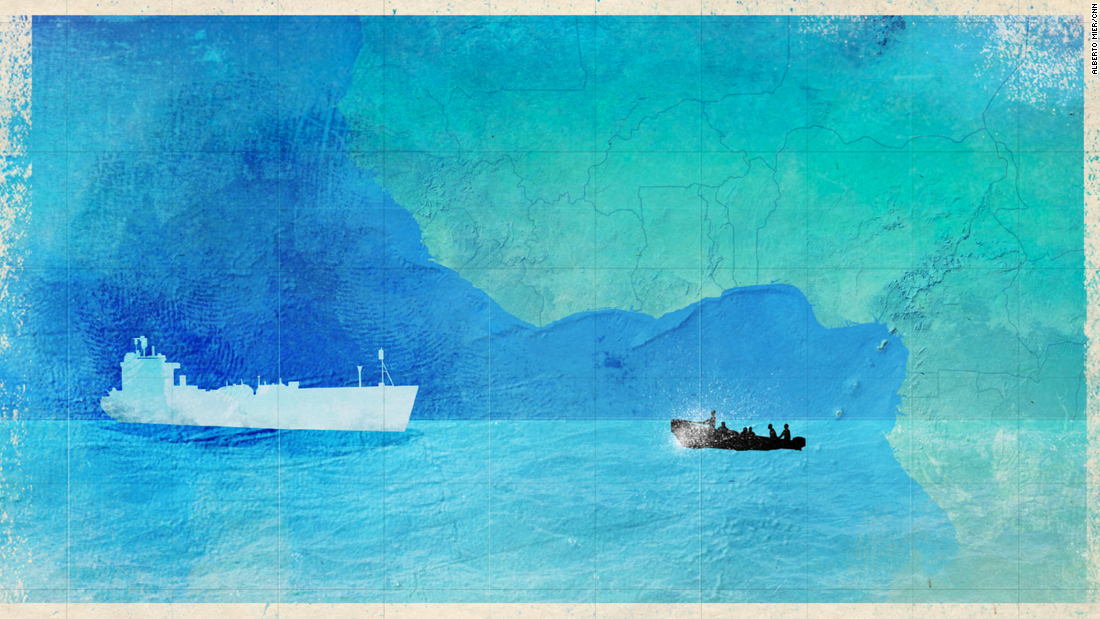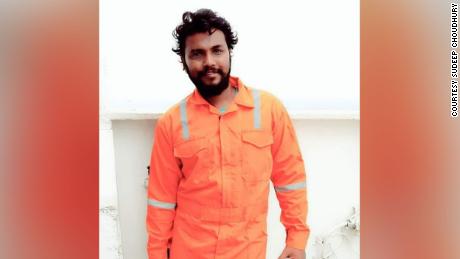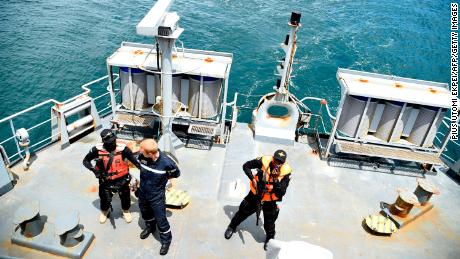The ship was about eight hours from port in Lomé, Togo, from where Prasad planned to fly home to Kolkata, India.
But, at 7:45 a.m., he got a call that would dramatically change his course.
Prasad’s chief engineer had seen a speedboat emerging from a supply vessel that had suddenly appeared beside their ship. By the time Prasad reached his ship’s bridge, or control room, the smaller boat was racing alongside them — and about half a dozen men on it were shouting for the MT Duke to slow down.
As Prasad and the engineer scrambled to the ship’s citadel, a reinforced room meant to protect the crew in case of an attack, they could see pirates climbing on to their vessel.
As the pirates banged on the citadel door, Prasad took a headcount. One sailor was missing. He knew the pirates were likely to break down the door before help arrived, so he made a decision.
The crew surrendered.
The kidnapping of Prasad and his crew in December 2019 exposes the perils for sailors in the Gulf of Guinea, off West Africa, now one of the world’s most-dangerous places for piracy. It borders Nigeria, Africa’s largest oil-producing nation, and is a hub for tankers coming and going from the region with lucrative cargo.
All of that trade requires a lot of shipping by vessels often primarily staffed by Indians. But in December, India’s Maritime Union (MUI) expressed “major concern” about the safety of Indian sailors in the Gulf of Guinea.
At a United Nations Security Council open briefing last month, India called for “an urgent need to increase surveillance to ensure maritime security in the area, through increased international collaboration.”
Security for sailors on ships off West Africa is becoming increasingly important for India as it ramps up its Nigerian crude oil imports. But the question remains how to deal with the pirates — and how to best protect Indian sailors.
Wading through swamps
Traditionally, Somali pirates have posed the biggest threat to cargo ships in waters off East Africa. However, the sea off West Africa now dominates international piracy reports.
Cyrus Mody, deputy director of the International Chamber of Commerce’s commercial crime services at IMB, said piracy has always existed in the Gulf of Guinea, but for a long time shipping companies didn’t report cases for fear of triggering higher insurance premiums or getting caught up in lengthy, complex investigations.
“The number of incidents reported from the Gulf of Guinea have never accurately identified the true picture or true levels of violence in this region,” he said.
The pirates that attacked the MT Duke were armed with automatic assault rifles and machetes. They assaulted the crew and ransacked the ship, inspecting cabins and grabbing whatever valuables they could find — wallets, watches, phones.
Prasad says he emptied the safe in his cabin and handed over $6,000. When they slapped him, Prasad told them that’s all there was. “Even if you kill me, I will have no money,” he said.
The crew consisted of 20 Indians and one Nigerian, who the pirates left behind when they discovered he was a training cadet. “They were not interested in him. They said his life is immaterial,” Prasad said.
The Indians were made to climb onto a speedboat that took them to the supply vessel which the pirates had hijacked the night before. About 30 hours later, the supply vessel with its Nigerian crew was released, Prasad said. He said his crew traveled for another three hours by speedboat to reach a swamp in the Niger Delta.
Many of the Indian sailors were still dressed in their nightwear, and waded through a knee-deep swamp in their shorts, boxers and slippers for 20 minutes until they reached a jungle camp, Prasad said.
Within a week, Brito D’Silva, an able seaman (a senior member of the deck on crew), died of an unspecified illness.
But the sailors’ ordeal had just begun.
Piracy moves west
Piracy in the Gulf of Guinea is an extension of the organized oil crime on land that has long been a source of revenue for petty criminals, corrupt officials and militant groups. Initially, armed robbers would board vessels to smuggle oil to sell in local markets. But in recent years, law enforcement both at land and sea has targeted the illegal trade, so pirates have turned to ransoms as another way to make cash.
Experts say stealing cargo is time consuming — it can take a couple of days — and extra policing means hijackers are more likely to be caught in the act. “The risk for this kind of operation has changed quite significantly,” says Dirk Siebels, a senior analyst at Risk Intelligence, a Denmark-based security intelligence company. “But if you’re kidnapping seafarers, you don’t need much time — one to two hours maximum. So, navies have very little time to respond.”
“The Duke incident,” says Siebels, “is kind of unusual because there were so many people who were kidnapped.” This is not completely unheard of. But it’s usually three to five people, he says, “and it’s usually the master, first officer, chief engineer — the sort of highest-ranking people — never mind the nationality, but those would be the people who would fetch the highest ransoms.”
For the Duke crew, pirates demanded 2 billion naira (about $5 million). The shipping company offered a fraction of that, about 2 million naira (about $5,000), according to Prasad, who accompanied the pirates while they negotiated for ransom via satellite phone.
“Our company was playing a cat-and-mouse game,” said Prasad. “They were just doing delay tactics, they were not interested in saving lives.” MT Duke is owned by Union Maritime Ltd, a UK-based owner and operator of chemical tankers. The company is a significant player in the West African oil trade. Their shipping operations in India are managed by V. Ships, a prominent global ship management company. CNN contacted both companies for comment but hasn’t received a response.
India imposes new rules
The world’s maritime industry is predominantly steered by Asian crews from developing countries. After Filipinos and Indonesians, Indians form the largest group with more than 200,000 seafarers — nearly one in 10 of the world’s total.
In recent years, dozens of Indians have been held for ransom.
In 2018, 39 Indian seafarers were seized by pirates in the Gulf of Guinea, according to data provided by Stable Seas, the maritime program of One Earth Future foundation, a Colorado-based incubator of peacebuilding programs.
Lydelle Joubert, an expert on maritime piracy at Stable Seas, says Indians weren’t specifically targeted — there were just more Indians aboard ships in the Gulf that year. High numbers of Russians, Ukrainians and Filipinos have also been kidnapped in recent years, she added.
In 2019, at least 47 Indians were kidnapped in four reported incidents. In the most dramatic of these cases in April, a small tanker — MT Apecus — was anchored off Nigeria’s Bonny Island, just seven nautical miles from land, waiting to enter the Nigerian port, when pirates kidnapped five Indians and one Nigerian from the crew of 15 on board.
“They took us in broad daylight,” says Sudeep Choudhury, the ship’s third officer.
Choudhury spent 70 days in captivity in his boxer shorts — he had jumped out of bed when the pirates attacked and had no time to get dressed. During that time he said the pirates gave him very little food and water.
Following that incident, India’s maritime authority, Directorate General of Shipping, issued an advisory in May 2019, which read: “Foreign nationals, especially Indian seafarers, are being selectively targeted during such piracy/armed robbery incidents.” It instructed recruiters to avoid engaging Indian seafarers on coastal vessels working solely within ports in the Gulf of Guinea.
Joubert, from Stable Seas, said the directive led to fewer Indians being kidnapped, but it didn’t solve the problem — five Indians were held for ransom in 2020.
That was partly because the rules only related to ships operating solely within the Gulf of Guinea. They did not apply to vessels like the Duke, which sail international waters, said Prasad.
Nigeria’s ‘kidnapping industry’
In the jungle camp, the seafarers were oscillating between fear and boredom. Captain Prasad told his teammates that D’Silva, the deceased seaman, was recuperating in the hospital so they didn’t panic. There was limited food and no sanitation. One day, the guards caught a king cobra that slithered dangerously close and cooked the snake for dinner.
The Indians were terrified — they took turns to keep a watch at night for wild animals and safety in general. “I used to tell them, ‘Just think about your families, don’t think about yourself and that will propel you,'” Prasad says.
At first, they slept on the ground in derelict huts. Then their kidnappers built newer huts using wood from the trees in the mangroves and tarpaulin. They were guarded by 15 armed men at all times, though the pirates who kidnapped them came and went,” Prasad said.
The guards at the camp were “educated, unemployed youth,” Prasad said. They “were from the same communities which had been exploited for oil … they said they were fighting against the government and they had to survive so they needed the money,” he added.
“The communities from where the oil is being exploited are not benefiting as much as they would like to,” said Mody, from the IMB. “The targeting of oil infrastructure and specifically vessels related to the oil industry were a means by which they were trying to express their dissatisfaction to their governments.”
Since the last quarter of 2019, the attacks are not only on ships related to the oil industry but on all types of vessels, farther from the coast. “It is going up to 200 miles from the coastline, that is a huge distance,” Mody said.
“Nigeria has a problem with kidnappings in general,” said Siebels. “The infrastructure is in place. You’ve got hostage camps, negotiators, foot soldiers … it’s basically an industry.”
Demand for ransoms
Nigerians are most vulnerable to kidnapping on land, but it’s much more profitable to attack people at sea.
“It’s a very lucrative business to attack seafarers because usually that’s covered by insurance and the ransoms that are paid up are usually quite significant in the context,” Siebels said.
There is limited data available on ransoms paid, but typically in the Gulf of Guinea it is about $50,000 to $60,000 per person, says Siebels. “If you have 20 people, you probably get — as bad as it sounds — you probably get a discount because you have such a number of hostages. But the overall ransom payment is obviously relatively high,” he said.
Paying higher ransoms only incentivize kidnapping, says Anja Shortland, a professor of political economy at King’s College in London, an expert on piracy ransom money.
“People talk. Criminal communities gossip. If you can pay $100,000 per sailor, that’s what people will come to expect. Then it’s difficult to budge them,” she said.
The problem with diverging from that path, she said, results in more violent kidnappings. “You get people who don’t know what they’re doing coming into the piracy business and it’s going to go wrong,” she said.
But that plan is a reactive measure — it doesn’t prevent kidnappings.
Prasad says his experience has put him off working in the Gulf.
After five weeks of negotiations, he says the pirates “got frustrated” and released them for $300,000, “comparatively a very small amount of money.”
Prasad said he and his teammates received $1,400 each as compensation from his employer, “not even three days’ wage for a Master of the vessel.”
It’s not just the financial impact that pains Prasad — last January, he was diagnosed with post-traumatic stress disorder (PTSD) caused by the kidnapping. Months later, he took an assignment on another ship.
Now, Prasad calls his wife “every day, morning and evening. If I don’t call her on time, she starts getting worried.”
And he vows he will never sail in the Gulf of Guinea again.
“If a vessel is going to West Africa, I will disembark, whatever situation it is.”







